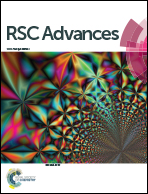Controlled synthesis of Pd and Pd–Au nanoparticles: effect of organic amine and silanol groups on morphology and polycrystallinity of nanomaterials
Abstract
The synthesis of palladium (PdNPs) and its bimetallic (Pd–Au/Au–Pd) nanoparticles of controlled nanogeometry, polycrystallinity and functional ability is a challenging task. We report a new process for metal nanoparticles synthesis meeting these requirements that incorporate the specific role of organic amine and silanol functionalities with the following major findings: (1) the concentrations of organic amine control the nanogeometry and functional ability of the nanoparticles; (2) the polycrystallinity of PdNPs tends to decrease as a function of silanol concentration justifying specific interaction of PdNPs and silanol groups whereas AuNPs do not show such interaction; (3) transition in microstructure from hexagonal nanogeometry to circular nanogeometry of palladium nanoparticles (PdNPs) in the presence of a silanol group; (4) initial reduction of palladium ions followed by reduction of gold ions during the synthesis of bimetallic nanoparticles results in negligible interaction of the silanol residue and PdNPs justifying an increase in polycrystallinity whereas simultaneous reduction of the same enable a decrease in polycrystallinity; (5) initial reduction of gold ions causes aggregation of the same forming larger nanoparticles and reveals negligible interaction with silanol content under similar conditions; (6) the size of nanoparticles decreases with an increase in silanol concentration as a function of nanoparticle–silanol interaction. As synthesized PdNPs shows peroxidase mimetic activity as a function of 3-APTMS concentration.


 Please wait while we load your content...
Please wait while we load your content...